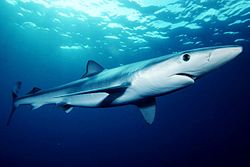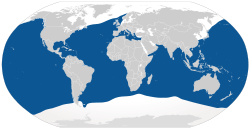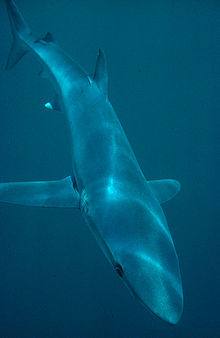
Blue shark
Background Information
The articles in this Schools selection have been arranged by curriculum topic thanks to SOS Children volunteers. Child sponsorship helps children one by one http://www.sponsor-a-child.org.uk/.
| Blue shark Temporal range: Pliocene–Recent |
|
|---|---|
 |
|
| Conservation status | |
 Near Threatened ( IUCN 3.1) |
|
| Scientific classification | |
| Kingdom: | Animalia |
| Phylum: | Chordata |
| Class: | Chondrichthyes |
| Subclass: | Elasmobranchii |
| Order: | Carcharhiniformes |
| Family: | Carcharhinidae |
| Genus: | Prionace Cantor, 1849 |
| Species: | P. glauca |
| Binomial name | |
| Prionace glauca (Linnaeus, 1758) |
|
 |
|
| Range of the blue shark | |
The blue shark (Prionace glauca) is a species of requiem shark, family Carcharhinidae, that inhabits deep waters in the world's temperate and tropical oceans. Preferring cooler waters, blue sharks migrate long distances, for example from New England to South America.
Although generally lethargic, they can move very quickly. Blue sharks are viviparous and are noted for large litters of 25 to over 100 pups. They feed primarily on small fish and squid, although they can take larger prey. Blue sharks often school segregated by sex and size, and this behaviour has led to their nickname "wolves of the sea". Maximum lifespan is still unknown, but it is believed that they can live up to 20 years.
Anatomy and appearance
Blue sharks are light-bodied with long pectoral fins. The top of the body is deep blue, lighter on the sides, and the underside is white. The male blue shark commonly grows to 1.82 to 2.82 m (6.0 to 9.3 ft) at maturity, whereas the larger females commonly grow to 2.2 to 3.3 m (7.2 to 11 ft) at maturity. Large specimens can grow to 3.8 m (12 ft) long. Occasionally, an outsized blue shark is reported, with one widely-printed claim of a length of 6.1 m (20 ft), but no shark even approaching this has been confirmed in this species. The Blue Shark is fairly elongated and slender in build and typically weighs from 27 to 55 kg (60 to 120 lb) in males and from 93 to 182 kg (210 to 400 lb) in large females. Occasionally, a female in excess of 3 m (9.8 ft) will weigh over 204 kg (450 lb). The heaviest reported weight for the species was 391 kg (860 lb).
Reproduction
They are viviparous, with a yolk-sac placenta, delivering 4 to 135 pups per litter. The gestation period is between 9 and 12 months. Females mature at 5 to 6 years of age and males at 4 to 5. Courtship is believed to involve biting by the male, as mature specimens can be accurately sexed according to the presence or absence of bite scarring. Female blue sharks have adapted to the rigorous mating ritual by developing skin 3 times thicker than male skin.
Ecology
Range and habitat
The blue shark is an oceanic and epipelagic shark found worldwide in deep temperate and tropical waters from the surface to about 350 meters. In temperate seas it may approach shore where it can be observed by divers, while in tropical waters it inhabits greater depths. It lives as far north as Norway and as far south as Chile. Blue sharks are found off the coasts of every continent, except Antarctica. Its greatest Pacific concentrations occur between 20° and 50° North but with strong seasonal fluctuations. In the tropics it spreads evenly between 20° N and 20° S. It prefers waters with a temperature range of 7–16 °C (45–61 °F) but will tolerate temperatures of 21 °C (70 °F) or above. Records from the Atlantic show a regular clockwise migration within the prevailing currents.
Feeding
Squid are important prey for blue sharks, but their diet includes other invertebrates such as cuttlefish and pelagic octopuses, as well as lobster, shrimp, crab, a large number of bony fishes, small sharks, mammalian carrion and occasional sea birds. Whale and porpoise blubber and meat have been retrieved from the stomachs of captured specimens and they are known to take cod from trawl nets. Blue sharks rarely eat tuna.
Predators
Adult blue sharks do not suffer predation on a regular basis, except by humans and killer whales. Young and smaller individuals may get eaten by any sufficiently larger sharks such as the Great White Shark and the Tiger Shark. However, they are host to several species of parasites. For example, the blue shark is the definite host of the tetraphyllidean tapeworm, Pelichnibothrium speciosum (Prionacestus bipartitus). They become infected by eating intermediate hosts, probably Opah, (Lampris guttatus), and/or longnose lancetfish, (Alepisaurus ferox).
Relationship to humans
It is estimated that 10 to 20 million of these species are killed each year as a result of fishing. The flesh is edible, but not widely sought after; it is consumed fresh, dried, smoked and salted and diverted for fishmeal. The skin is used for leather, the fins for shark-fin soup and the liver for oil. Blue sharks are occasionally sought as game fish for their beauty and speed.
As of 2009 there have been 13 recorded attacks on humans and 4 fatalities.
In captivity
Blue sharks, like most pelagic sharks, tend to fare poorly in captivity. Attempts at keeping them using circular tanks with long glide paths, and pools with 3 meters (9.8 ft) central depth gently ascending to zero depth have met with mixed results at best; most specimens last less than 30 days. As with other pelagic sharks, they seem to have trouble avoiding walls or other obstacles. In one case at Sea World San Diego, the Blue shark did fairly well until bull sharks were added to the tank; the Bull sharks ate the Blue shark. The captivity record for blue sharks as of 2008 was held by The New Jersey Aquarium for a specimen that lasted roughly 7 months before expiring of an apparent bacterial infection.


